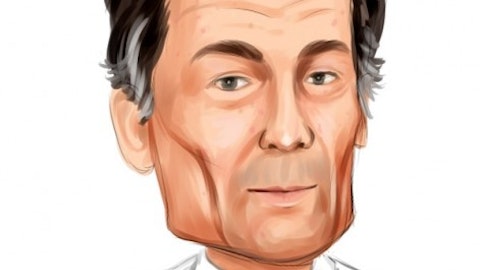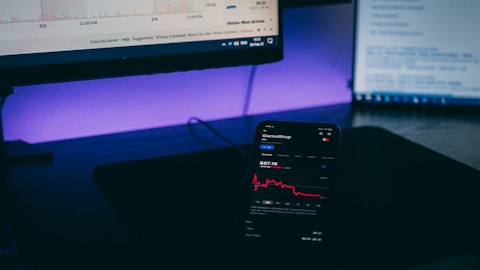CME Group Inc. (NASDAQ:CME) Q1 2024 Earnings Call Transcript April 24, 2024
CME Group Inc. beats earnings expectations. Reported EPS is $2.5, expectations were $2.44. CME isn’t one of the 30 most popular stocks among hedge funds at the end of the third quarter (see the details here).
Operator: Welcome to the CME Group first quarter 2024 earnings call. At this time, all participants are in a listen-only mode. During the Q&A session, if you’d like to ask a question, you may press star, one on your phone. I’ll now turn the conference over to Adam Minick. Please go ahead.
Adam Minick: Good morning, and I hope you’re all doing well today. We released our executive commentary earlier this morning, which provides extensive details on the first quarter 2024, which we will be discussing on this call. I’ll start with the Safe Harbor language, and then I’ll turn it over to Terry. Statements made on this call and in the other reference documents on our website that are not historical facts are forward-looking statements. These statements are not guarantees of future performance. They involve risks, uncertainties and assumptions that are difficult to predict, therefore actual outcomes and results may differ materially from what is expressed or implied in any statement. Detailed information about factors that may affect our performance can be found in our filings with the SEC, which are on our website.
Lastly, on the final page of the earnings release is a reconciliation between GAAP and non-GAAP measures. With that, I’ll turn the call over to Terry.
Terrence Duffy: Thanks Adam, and thank you all for joining us this morning. I’m going to make a few brief comments about the quarter and the overall environment. Following that, Lynne will provide an overview of our first quarter financial results. In addition to Lynne, we have other members of our management team present to answer questions after the prepared remarks. Our performance in the first quarter was strong evidence of the ever-growing need for risk management globally. First quarter average daily volume of 24.6 million contracts was the third highest quarterly ADV in CME Group’s history. The only higher quarters were the first quarter of 2020 at the onset of the pandemic, and the first quarter last year, which was impacted by the significant bank turmoil in March and created a much tougher comparison for March of 2024.
Despite not specific macro event or change in Federal Reserve rates occurring in Q1, we had the highest January ADV to date, up 16% year-over-year, and a February that included the highest monthly interest rate ADV in our history of 17.2 million contracts, or up 6%. We achieved quarterly ADV records for both treasuries of 7.8 million contracts and the overall options of 5.9 million contracts. Both equity index and energy options reached all-time high levels. Our non-U.S. ADV also reached a record level of 7.4 million contracts. This was driven largely by 38% growth in energy, 29% in ag products, and 7% in metals. In total, we delivered 14% ADV growth across our physical commodity products to 4.7 million average daily volume, which included 16% year-over-year growth for both energy and ag products.

This strong first quarter activity across our business lines helped generate record adjusted quarterly financial results which Lynne will detail in just a moment. Activity so far in April has continued to build on many of these trends following the strong first quarter of our physical commodity asset classes. They are up 26% to date in April as of April 22. Metals ADV specifically is up 76% and the complex reached its highest daily volume in history of 1.7 million contracts on April 12. On the financial side of the business, the CPI released on April 10 was a great example of how important every data point is for the market to adjust positions to manage risk. We reached nearly 44 million contracts traded that day and the wide range of views around the health of the global economy and the nuance related to interpreting the many different economic indicators continues.
As a result of the strong market dynamics, year-to-date through April 22, our ADV is up 4%, including year-over-year growth in all six of our asset classes. CME Group continues to provide deep, liquid markets across global benchmarks to deliver the most operational and capital efficiencies to market participants. CME Group’s multi-asset class offering is in higher demand today than ever. I’m now going to turn the call over to Lynne to review our financial results.
Lynne Fitzpatrick: Thanks Terry, and thank you for joining us this morning. During the first quarter, CME generated nearly $1.5 billion in revenue, up 30% from a very strong first quarter in 2023. Within the physical commodities asset classes, quarterly revenue was up 14% year-over-year and represented approximately one-third of clearing [indiscernible] in the quarter. Market data revenue reached a record level of 6% to $175 million. Other revenue increased 37% to $104 million, largely due to the increased non-cash collateral fee implemented in January. Continued strong cost discipline led to an adjusted expenses of $462 million for the quarter and $374 million excluding license fees. Our adjusted operating margin for the quarter was 68.9%, up from 68.2% in the same period last year.
CME Group had an adjusted effective tax rate of 23%. Driven by the strong demand for our risk management products, we delivered the highest quarterly adjusted net income and earnings per share in our history at $911 million and $2.50 respectively, both up 3% from the first quarter last year. This represents an adjusted net income margin for the quarter of over 61%. Capital expenditures for the first quarter were approximately $16 million, and cash at the end of the period [indiscernible] $1.7 billion. CME Group paid dividends during the quarter of approximately $2.3 billion or nearly $25 billion [indiscernible] form of dividends since [indiscernible] variable dividend policy in early 2012. We’re very proud to deliver [indiscernible] quarterly earnings in our history and are pleased to see this strong start [indiscernible] second quarter.
Year to date through April 22, 42 or more than half of our trading days have been over 25 million contracts, versus 28 days last [indiscernible] more consistent higher demand for our [indiscernible]. At CME Group, we continue to focus on providing the risk management products needed by our clients and driving earnings growth for our shareholders. We’d now like to open up the call to your questions.
See also 12 Best All-Time Low Stocks To Invest In and 20 Most Competitive Countries in Asia.
Q&A Session
Follow Cme Group Inc. (NASDAQ:CME)
Follow Cme Group Inc. (NASDAQ:CME)
Receive real-time insider trading and news alerts
Operator: The phone lines are now open for questions. [Operator instructions] The first question in the queue is from Chris Allen with Citi. Your line is now open.
Chris Allen: Yes, morning everyone. Thanks for taking my question. I wanted to focus on the U.S. treasury complex – record activity in the quarter. Obviously there was a lot of chatter out there, maybe some more peak rate activity – does not seem to be the case, but maybe how are you thinking about the U.S. treasury complex, what’s driving it? Any color on the impact from the CME DTCC cross-margining, and then also U.S. treasury clearing, which you’ve applied to clear the cash U.S. treasury, how are thinking about that from a structural impact perspective but also if there’s any revenue opportunities around that. Sorry for the multi-part question.
Terrence Duffy: No problem, Chris. Again, we’ll unpack that a little bit, and then I’m going to ask Tim, probably Suzanne and myself will all kind of answer the three different parts of it. Let’s just talk about–I think the first part of your question was around is it the peak activity around treasuries. I think that would be really difficult to draw that conclusion in lieu of what’s going on fundamentally around the world and in the United States, so I just don’t see how anybody can draw a conclusion that this is the peak of that activity. Activity should generate more, if in fact the Fed does cut, so that would generate more activity. It doesn’t need to just go up in order to generate activity, as you know, Chris, so I would say that it’s a far way of saying that we are not near a peak as it relates to activity in the treasury market. As far as the DTCC and the clearing, I’ll let Tim and Suzanne respond to that respectively.
Suzanne Sprague: Yes, thank you very much, Terry, and thank you for the question. We do continue seeing increased participation in the cross-margin program between ourselves and the fixed income clearing corporations. Some of those clearing members are seeing upwards of 75% to 80% in margin savings, and that’s in addition to the portfolio margining program that we offer within CME between our interest rate futures, options and swaps, which in the first quarter of 2024 continued delivering average daily savings of about $7 million, so holistically those capital efficiencies solutions, I think have been a great story for market participants in achieving record savings over time and continued consistent savings for the first quarter of this year.
Terrence Duffy: Tim, you have anything to add?
Tim McCourt: Chris, I think maybe just the one thing to add on the treasury complex is when we look at the long term growth of that complex, the volume and open introduce continue to grow with the stock of outstanding treasuries, and over the last 10 years, the stock of that treasury has roughly doubled and when we look out, the congressional budget office also is forecasting it to double over the next 10 years. When we look to where the total net issuance is currently occurring in Q1, while it was little changed from Q4 in terms of the net issuance, it was much more coupon-heavy than previous quarters, and when we look as the treasury ramps up in notes and bonds to issue that finance these growing budget deficits, that plays very well into the complex of the products that we offer and, as Terry stated in his remarks, furthering the growth that we’ve seen where the treasury complex had the record Q1 of 7.8 million contracts across futures and options, and we expect the general issuance backdrop to continue to be a tailwind for that complex.
Terrence Duffy: And Chris, let me just add to one thing that I was going to say at the beginning, but on the treasury complex, to say that as it peaked, you know and everybody on the call knows that the different amount of opinions that’s out there related to what the Fed is going to do or not do is all over the map, and everybody’s been absolutely, for the most part wrong. You had anywhere from six rate cuts predicted six months ago coming into ’24, to three that was advertised by the Fed, now people are going anywhere between zero, none, and somewhere in between that. I have no idea what’s going to happen, but there’s a big difference of opinions out there which also generate a tremendous amount of activity. One of the things we don’t talk about, and we haven’t talked about since SVB failed, was their duration risk, and I’m not suggesting others are going to fall into this, but the longer that rates are higher, you have to think that others are watching this and need to make sure they manage that risk on duration.
I think that’s an equation that most people that are sitting on these treasuries was not accounting for, say just as little as three to six months ago.
Chris Allen: Appreciate the color. Anything on U.S. treasury clearing?
Terrence Duffy: On the U.S. treasury clearing, I will say that we–I made the announcement that we are going to file an application as it relates to this. We are in the very early stages of completing that application. I think we’ve said publicly that we’ll probably look at some time in the fourth quarter before we can have that being viewed by the SEC, and then we’ll go from there; but again, I think from our standpoint, the mandate doesn’t kick in until sometime in ’26, and we’ll be prepared either way to go forward with it if it’s in the best interest of CME and its participants.
Chris Allen: Thank you.
Terrence Duffy: Thanks Chris.
Operator: The next question in the queue is from Dan Fannon with Jefferies. Your line is open.
Dan Fannon: Thanks, good morning. Was hoping to get a little more color on some of the activity in the commodities and metals markets, maybe talk about the health of the customer given the robust increase in volumes. Has there been any change in position limits or other things that might potentially curtail some of the activity that’s been happening?
Terrence Duffy: Derek?




